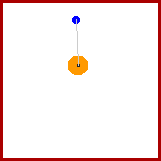Hello followers. You guys have heard me mention Tycho Brahe at one point or another, and in my last post I said that I would touch upon our relationship. Well, here we go.
Tycho was an astronomer who spent years carefully measuring the positions of the stars and planets to an unprecedented accuracy. He was not particularly gifted in mathematics, however, and could not make sense of his observations. That's where I came in. I don't usually brag, but I must say that I am an incredibly gifted mathematician, and Tycho recognized this. He offered me a position as an assistant so I could make sense of his observations, and offered to mentor me.
There were a few problems with our relationship, though. We did not get along at all, due to our varying opinions on the universe. As stated before, I strongly believed in Copernicus's heliocentric model of the universe. Tycho, on the other hand, developed his own model where the Sun and the moon circled the Earth, and the other planets circled the sun. Also, my lifestyle differed very much from his. He was born into an upper class lifestyle, and enjoyed throwing lavish feasts and often gorged himself with food and wine.
Another reason for our quarreling was due to the fact that Tycho did not trust me. He saw me as a potential rival, and feared that I would use his research to become more famous than him. He also wasn't eager to have his work used to support the Copernican theory as opposed to his own. So he withheld his information from me, and kept me busy with the task of studying the orbit of Mars. I spent eight years working on the orbit of Mars, and as it turned out it was a good basis to research many of my theories.
Tycho's lifestyle caught up with him, though, and he became very ill after a banquet and soon died. Tycho's heirs were eager to make money off of his information, and I had to take...ahem, drastic measures to achieve the information that led me to formulate the Laws of Planetary Motion. I admit it, I stole his information. But just think about what I was able to accomplish! It was all for a good cause, right? I'm sure modern physicians are glad I did it.
Tycho's lifestyle caught up with him, though, and he became very ill after a banquet and soon died. Tycho's heirs were eager to make money off of his information, and I had to take...ahem, drastic measures to achieve the information that led me to formulate the Laws of Planetary Motion. I admit it, I stole his information. But just think about what I was able to accomplish! It was all for a good cause, right? I'm sure modern physicians are glad I did it.
All's well that ends well, right? Although I did not agree with Tycho on many levels, he was a brilliant observer and without him I could not have accomplished much of my work. Until next time,
Johannes Kepler







